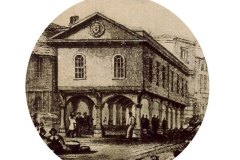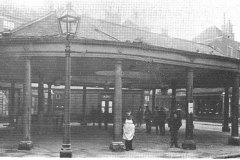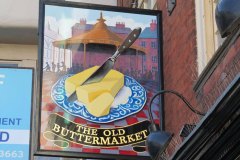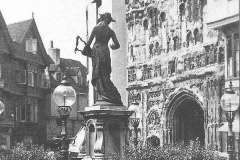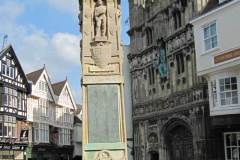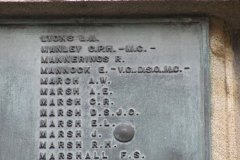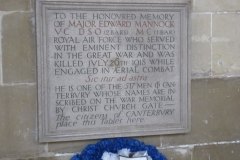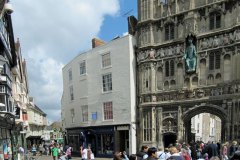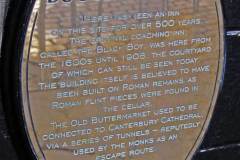The Buttermarket site, which includes the Christchurch Gate entrance to the cathedral, has been through several transformations over the past 500 years. Up until the mid-17th century, it was known as the Bull Stake, as bulls were tied overnight against a stake to be ‘baited’ by dogs, with the expectation that this would produce more tender meat. The slaughter area of the city, known as the shambles, was nearby in Butchery Lane. In 1664, John Somner, brother of the writer and historian William Somner, paid for a market hall, with a theatre and store rooms above an open-arched space which acquired the name of Buttermarket. No images survive but we have a good description from a booklet published by John Somner when he was in dispute with the corporation over maintenance costs – the image shown here (image 1) fits the description well. By the late 1790s, Somner’s timberwork had decayed, and the city corporation found £450 for a replacement single storey market (image 2) with a large oval canopy supported on 16 columns. It appears, partly obscured by a large plate of butter, on current the pub sign (image 3). Despite re-roofing in the 1820s, weather and time took their tolls, and the oval canopy was demolished in 1888 to make way for the city’s memorial to Christopher Marlowe (image 4), unveiled in 1891 by the renowned actor Sir Henry Irving. The memorial took the form of a female muse, who appeared naked, semi-clad or in diaphanous wrap, according to your viewpoint. The overwhelming consensus was that the muse, now nicknamed ‘Kitty’, had no place at the entrance to a cathedral, and she was banished to Dane John gardens in 1921 to make way for Canterbury’s World War I memorial (image 5). Kitty was moved in 1993 to her present site in front of the New Marlowe Theatre. It took the Memorial War Committee six years, a public referendum, and many public meetings to agree proposals for the memorial. Once the site and form of the memorial was agreed, there remained a dispute over which names should be included on the memorial plaque – in particular the treatment of Major Edward Mannock VC, the most highly decorated RAF pilot of the war. Mannock had enlisted in London. His Canterbury links were limited to having spent his school years here, clearly insufficient to meet the agreed criteria. But public opinion supported his inclusion, and his name was added to the plaque (image 6) to add to his cathedral memorial (image 7). The memorial is of Doulting Stone. Property to the left of the Christchurch gate (image 8) has been linked to the Elizabethan dramatist John Lyly; the Christchurch Gate Hotel to the right has less certain links with T S Eliot (when his drama Murder in the Cathedral was performed in the Chapter House in June 1935) and with C S Lewis (who stayed at the hotel when in the 1940s he was researching material for his The Lion, the Witch and the Wardrobe). A plaque on the Old Buttermarket pub (image 9) provides further historical background – some of which (escape tunnels for monks) seems speculative.
What to see:
- the pub sign showing the old oval market hall (Image 3)
- the war memorial with Mannock’s name (Image 5)
- Christ Church gate is described on a separate page
Sources: Bateman (1991); Cameron (2005); Donaldson (2006); Gostling (1825); Lyle (2008); Manners (2011)
DL

